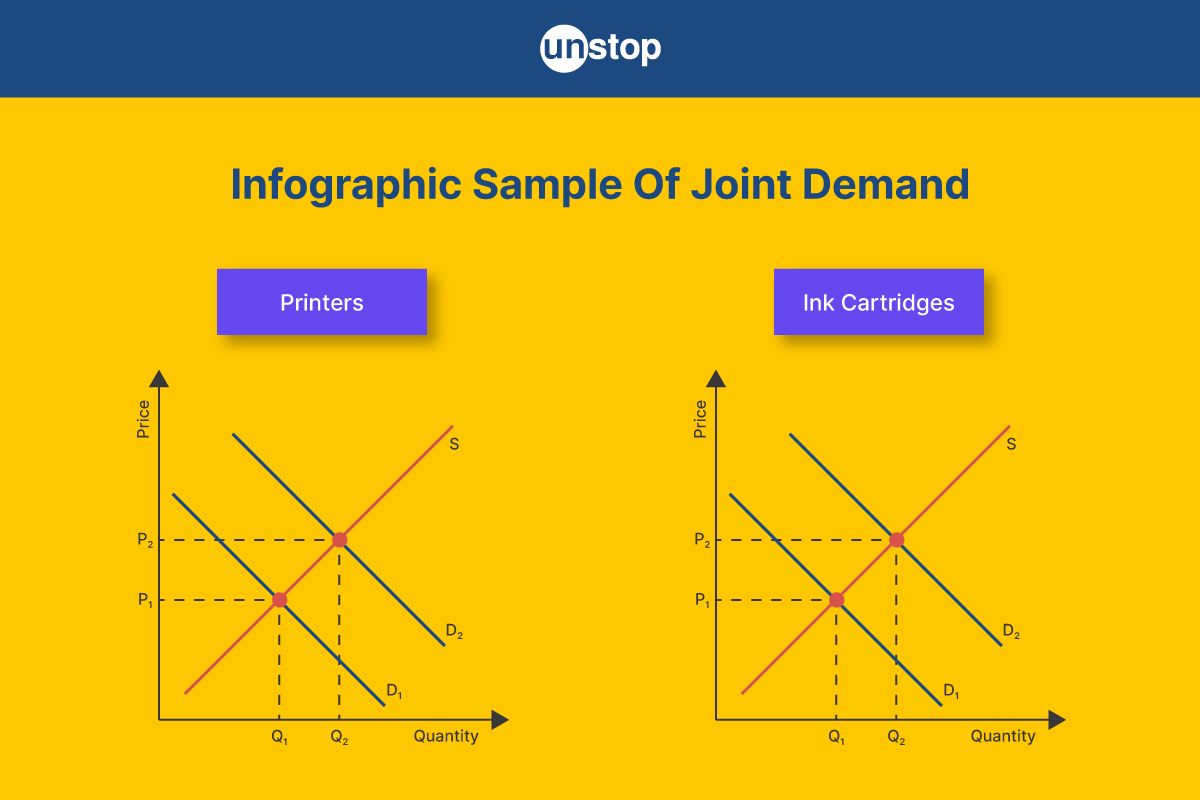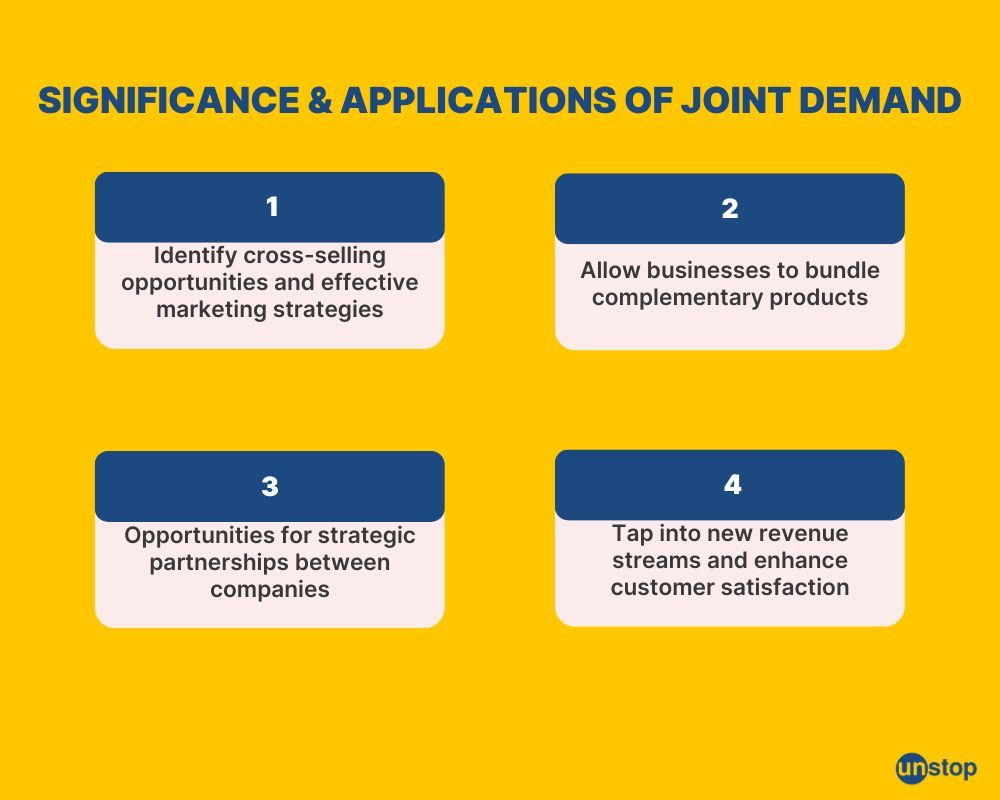- Joint Demand: Defined & Explained With Examples
- Derived Demand: Defined & Explained With Examples
- Difference Between Joint Demand & Derived Demand
- Applications & Advantages Of Joint Demand
- Frequently Asked Questions (FAQs)
Joint Demand Vs Derived Demand: Definition, Example & Difference

Joint demand is an indispensable concept in the world of business. It refers to the simultaneous demand for two or more goods that are used together. Understanding this phenomenon is essential for businesses looking to effectively market complementary products. Joint demand plays a significant role in shaping consumer behavior and purchasing decisions. By recognizing the relationship between products and their joint demand, brands can strategically position themselves in the market and create targeted marketing campaigns that cater to consumer preferences.
Joint Demand: Defined & Explained With Examples
Joint demand is a concept in economics that refers to the simultaneous demand for multiple goods or services. It occurs when two or more products are consumed or used together, creating interdependence in their consumption patterns. In other words, the demand for one product influences the demand for another, leading to a positive correlation between their sales.
Simultaneous Demand For Multiple Goods Or Services
When we talk about joint demand, we're talking about situations where people want to buy two or more things at the same time because they go hand in hand. For example, think about peanut butter and jelly. 
Image credit: Freepik
When you want to make a peanut butter and jelly sandwich, you need both peanut butter and jelly. You wouldn't typically buy just one without the other because they complement each other.
Interdependence In Consumption Patterns
In joint demand scenarios, the consumption patterns of different products are interconnected. This means that if there's an increase in the demand for one product, it will likely lead to an increase in the demand for another product as well. For instance, if there's a surge in the sales of smartphones, it will also drive up the demand for smartphone accessories like phone cases and screen protectors.
Positive Correlation Between Sales
The relationship between products experiencing joint demand is characterized by a positive correlation between their sales figures. As one product becomes more popular and experiences higher sales numbers, it has a spillover effect on the sales of related products. This correlation can be seen across various industries and sectors.
Importance For Businesses' Marketing Strategies
Understanding joint demand is influential for businesses as it allows them to optimize their marketing strategies effectively. By recognizing which products have joint demands with their offerings, businesses can develop targeted marketing campaigns that highlight these complementary relationships. This can help attract customers who are already interested in one product and encourage them to purchase related items as well.
To illustrate this further, let us a restaurant where combo meals are offered as a main dish, a side, and a drink are bundled together. This capitalizes on the joint demand for these items and encourages customers to purchase them as a package deal. 
Image credit: Freepik
Another example is the gaming industry, where video game consoles are often sold alongside popular game titles. The joint demand for consoles and games creates a mutually beneficial relationship, driving sales for both products. 
Image credit: Freepik
Printers & Ink Cartridges
One classic example of joint demand is the relationship between printers and ink cartridges. When someone purchases a printer, they also need ink cartridges to use it effectively. The printer itself becomes useless without the necessary ink to print documents or images. This creates a situation where consumers have to buy both items together, leading to joint demand.
Smartphones & Phone Accessories
Another example of joint demand can be seen in the smartphone industry. Consumers who purchase smartphones often find themselves buying additional accessories like cases, chargers, and screen protectors. These accessories complement the functionality and protection of the smartphone, making them essential for many users. As a result, there is a strong correlation between the demand for smartphones and phone accessories.
Tires & Cars
In the automotive industry, tires and cars exhibit joint demand. Vehicles require specific types of tires for optimal performance on different terrains and weather conditions. When individuals purchase a car, they also need to consider buying compatible tires suitable for their vehicle. The choice of tires directly impacts the driving experience and safety, highlighting the interdependence between cars and tires.
Software & Hardware
The relationship between software and hardware also demonstrates joint demand. Certain software applications can only run on compatible hardware devices due to technical specifications or operating system requirements. For example, video editing software may require high-performance processors or dedicated graphics cards to function properly. Consequently, consumers who wish to use such software must ensure that their hardware meets the necessary criteria.
These examples illustrate how joint demand affects consumer behavior by creating interconnected relationships between goods or services. Understanding this concept helps businesses strategize their marketing efforts by recognizing which products are typically purchased together. By recognizing these patterns, companies can bundle products or create promotional discounts to encourage consumers to buy complementary items simultaneously. This approach not only maximizes sales but also enhances customer satisfaction by providing a convenient and comprehensive purchasing experience.
The Role Of Market Research
Market research plays a crucial role in identifying potential opportunities arising from joint demands within specific industries. By conducting thorough market research, businesses can gain insights into consumer behavior, preferences, and buying patterns related to complementary goods.
Through surveys, focus groups, and data analysis, companies can uncover patterns of joint demands among consumers. This information helps them develop effective pricing strategies by understanding how consumers perceive the value of bundled products compared to purchasing items separately.
Derived Demand: Defined & Explained With Examples
Derived demand refers to the demand for a product or service that arises from the demand for another product or service. In other words, it is a demand that is derived from the demand for something else. This concept is often used in economics to explain the relationship between different goods and services in a market.
It highlights that the demand for a particular product or service is not always independent but can be influenced by the demand for another related product or service. For example, the demand for raw materials used in manufacturing depends on the demand for the final goods produced using those materials.
Understanding derived demand is vital for businesses as it helps them make informed decisions regarding production, pricing, and resource allocation. By analyzing the derived demand for their products or services, companies can identify the key factors that drive demand and adjust their strategies accordingly. For instance, if the demand for a particular product is declining, businesses can explore alternative markets or adjust their production processes to meet the derived demand for related products.
Furthermore, derived demand also has implications for the labor market. The demand for certain types of labor is derived from the demand for specific goods or services. For instance, the demand for software developers is derived from the demand for software products. This understanding can help individuals make informed career choices and acquire the necessary skills that align with the derived demand in the job market. It emphasizes the interconnectedness of different goods and services and how the demand for one can be influenced by the demand for another.
Difference Between Joint Demand & Derived Demand
Joint demand and derived demand are two concepts that are often used in economics to describe different types of demand. Understanding the difference between these two types of demand is essential for businesses and economists to effectively analyze and respond to market trends. Let us go through the difference between the two from the table below:
Joint Demand |
Derived Demand |
|---|---|
|
Refers to the demand for two or more goods that are used together |
Refers to the demand for a good or service that is derived from the demand for another good or service |
|
Example: The demand for hot dogs and hot dog buns |
Example: The demand for construction workers due to the demand for new housing |
|
Joint demand is independent of price changes |
Derived demand is dependent on the price and demand for the related good or service |
|
Joint demand is influenced by factors such as consumer preferences and complementary goods |
Derived demand is influenced by factors such as the price and demand for the related good or service, as well as factors like technology and production processes |
|
Joint demand can create economies of scale and increase efficiency in production |
Derived demand can create job opportunities and impact employment levels in certain industries |
|
Joint demand is often seen in goods that are consumed together or used in conjunction with each other |
Derived demand is often seen in industries where goods or services are used as inputs in the production process |
|
Joint demand can be influenced by marketing and advertising efforts |
Derived demand can be influenced by changes in consumer preferences and technological advancements |
|
Joint demand can lead to complementary pricing strategies |
Derived demand can lead to changes in resource allocation and production decisions |
|
Joint demand can result in joint production and distribution efforts |
Derived demand can result in changes in the demand for inputs and resources |
|
Joint demand can be influenced by changes in consumer tastes and preferences |
Derived demand can be influenced by changes in the overall demand for the final good or service |
Applications & Advantages Of Joint Demand
By understanding consumer behavior patterns related to joint demands, companies can optimize their product offerings, identify cross-selling opportunities, and develop effective marketing strategies. It also allows businesses to bundle complementary products together, which can increase overall sales and customer satisfaction. This strategy involves offering two or more products that are commonly used together as a package deal. One significant advantage of identifying joint demands is its impact on pricing strategies. 
In addition to optimizing sales strategies, recognizing joint demands also opens up opportunities for strategic partnerships between companies. Businesses can collaborate with other organizations that offer complementary products or services to create bundled solutions for customers. By leveraging joint demand in the market, businesses can tap into new revenue streams and enhance customer satisfaction.
Conclusion
In conclusion, joint demand and derived demand are two important concepts in economics. Joint demand refers to the demand for two or more goods that are used together, whereas derived demand refers to the demand for a good or service that is derived from the demand for another good or service. Understanding the differences between these two types of demand is crucial for businesses and policymakers in order to make informed decisions about production and pricing strategies.
Frequently Asked Questions (FAQs)
1. What are some real-life examples of joint demand?
Joint demand can be observed in various industries and everyday life. For instance, peanut butter and jelly have a joint demand as they are often consumed together in sandwiches. Similarly, printers and ink cartridges exhibit joint demand since consumers require both items to fully utilize the printer's functionality.
2. How does joint demand differ from derived demand?
While both concepts involve interconnected demands, there is a distinction between them. Joint demand refers to goods that are consumed together simultaneously, like bread and butter. On the other hand, derived demand relates to goods whose consumption depends on the production or use of another product, such as labor required for manufacturing.
3. Can understanding joint demand benefit businesses?
Absolutely! Recognizing joint demands allows businesses to optimize their marketing strategies by offering complementary products or creating bundled deals. By satisfying customers' needs holistically with related items, companies can increase customer satisfaction and drive higher sales volume.
4. Is there any downside to relying on joint-demand strategies?
One potential drawback of focusing solely on joint-demand strategies is that it may limit diversification opportunities for businesses. Overemphasizing one specific set of complementary goods might hinder exploration into other potential markets or partnerships.
5. How can businesses identify joint-demand relationships?
Market research, customer surveys, and analyzing purchasing patterns are effective methods for identifying joint-demand relationships. By understanding consumer behavior and preferences, businesses can uncover which products are frequently consumed together and leverage that knowledge to their advantage.
Suggested reads:
- Inflation Vs Deflation: Differences, Causes & Effects Explained
- What Is Glocalization? A Detailed Explanation With Examples
- Experience Curve: An Effective Guide For Strategic Success
- J-Curve: Usages & Effects On Economics And Private Equity
- Capitalist Economy: Definition, Evolution, Features & Merits
Instinctively, I fall for nature, music, humor, reading, writing, listening, traveling, observing, learning, unlearning, friendship, exercise, etc., all these from the cradle to the grave- that's ME! It's my irrefutable belief in the uniqueness of all. I'll vehemently defend your right to be your best while I expect the same from you!
Login to continue reading
And access exclusive content, personalized recommendations, and career-boosting opportunities.
Subscribe
to our newsletter
















Comments
Add comment